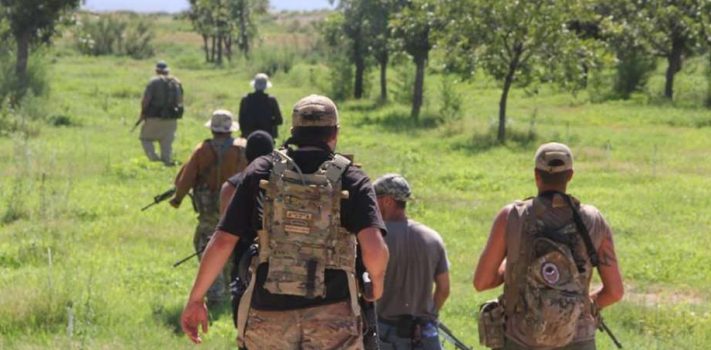We should be working with our neighbors to secure our local areas using the resources of a small and like-minded community. Here in remote Montana, where most of my neighbors have large banners hanging on their fences declaring support for Trump, the odds are higher that this community recognizes that they have a mutual liberty interest and will work together at various levels. This is the kind of community we should live in.
Security will be job number one. Establishing a simple-to-use radio communication system to replace a telephone system as a first step can be the core of a community security operation. If our plan is to hole up in our property and defend ourselves as if it is were The Alamo, then we are less likely to be successful against large roving gangs that will eventually be picking off neighbors, one by one. They will employ a well-proven tactic called Concentration of Force. But we can make this tactic less effective if we can be well organized and draw on the manpower and resources of a community. We can use a layered defense that is projected as far outside the community as is practical. We should use patrols to extend our defensive space and to deny the enemy key terrain and the ability to organize an attack upon us. Our radio communications plan for a security operation can be developed separately and designed and used to be as secure as feasible.
Tactical Radio Techniques
Low power transceivers are an advantage and using obscure frequencies helps to mitigate the likelihood of jamming and eves dropping. Use tones and have an alternative frequency as jamming will be used to deny an ability to coordinate. MURS Dakota Alert Sensors that use MURS frequencies– that are license-free frequencies — can also be a part of a security operation, is a good first step and choice. Yet there are also more obscure frequencies. If there is a licensed Amateur Radio enthusiast in your neighborhood with a basic understanding of radio, then they can develop a more sophisticated and robust radio communications plan using open-banded Baofeng radios, such as the Baofeng UV5R, or the better constructed and higher in quality Baofeng UV-82. Folks using these radios need master them, because a more sophisticated the technology, the more likely it will not be usable in the field. If using any handheld radio, always use the key pad lock before resuming operation.
Marine band radios are a good choice as they are operator friendly, use relatively obscure frequencies, are typically water resistant, and have available 25-watt mobile transceivers that need no advanced technical knowledge. A more powerful can extend the range, and a 25 watt VHF set is usually all that is needed. However, separate radio would be needed to monitor MURS Dakota Alert Sensors. Open-banded and versatile Chinese radios can use both Marine Band and MURS frequencies. A 25-watt mobile Marine Band transceiver can overpower a jamming effort using common and popular Chinese radios.
Converted mobile Amateur radios/transceivers can deliver up to 80 watts or more with high-gain antennas, and those can better overpower a jamming effort. A man-pack radio for a patrol using a high-power mobile radio is an option, however using a handheld with no more than 2 watts of power should be dictated in the local Signals Operating Instructions (SOI), I typically find that a 2-watt UHF signal to provide adequate coverage, and the UHF signal is pleasantly limited in range, so is the best choice for COMSEC most of the time. I should also mention that a half-watt FRS radio is more secure than a 5-watt 2-Meter radio. Easy to use and low-powered FRS/GMRS that are limited to 2 watts are a good substitute for a local phone system. A high-power GMRS could be used as a base station radio that can talk to common FRS/GMRS handhelds.
You’ll Need Food!
While I can talk about radios all day, a more important topic is food. In my experience, very few preppers these days have enough food, nor the ability to grow more food. Without enough food, a community will fight each other for resources, in particular, food, instead of cooperating with each other in defense of roving gangs and local warlords. And there is safety in numbers as evil persons within and outside the community would fear the consequences of their evil deeds. All scenarios considered, there is a significant tactical advantage of bringing more guns to the fight than the attackers can bring to your community. The best way to win a gunfight is to bring bigger guns and more guns to bear to establish fire superiority that can overwhelm even better-trained and organized attackers. But the only way to ensure that we are not fighting amongst ourselves is to have an adequate supply of dry staple goods, and garden seeds to grow very large gardens for the future supply, the excess of which can be donated to a community.
Tools For Organization
As a tool to organize a community, I have found the books, Volume 1 and 2 of The Civil Defense Manual to be powerful. The information therein could strengthen your community. It can be the centerpiece of discussion and a blueprint for a plan for a superior mutual defense of life and liberty, if the resources of a community can be employed. We would not be forming a ‘militia’, but rather a ‘community watch’ on steroids. Only by establishing secured communities will we have a better chance to rebuild. Individual families, without a community for support, will not fare as well in the future. The reward of establishing a secure small community is worth the risk. I would also recommend the Tactical Wisdom series of books by Joe Dolio, and The Guerilla’s Guide to the Baofeng Radio by NC Scout. In closing, I give special thanks to Jack Lawson, the author of the Civil Defense Manual.










